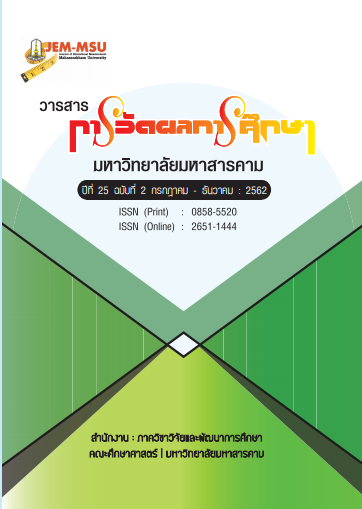Development of Logical-Mathematical Intelligence of Primary School Students: Behavioral Study
Main Article Content
Abstract
The purposes of this study were: 1) to design activities to develop the logical-mathematical intelligence basing on mathematical modelling; and 2) to study the results of using the developmental activities on the logical-mathematical intelligence of primary school students before and after using the logical-mathematical intelligence developmental activities that had been developed. The research was a behavioral study. The sample consisted of 160 grade 5 students from Watplongchangphouk School, Klaeng District, Rayong Province. The developmental activities were composed of logical- mathematical intelligence developmental activities. To study the results of using the intelligence developmental activities, the pre-test and post-test scores of the experimental and control groups were compared.
The results were found as follows:
1. The design of the developmental activities for development of the logical-mathematical Intelligence of primary school students was characterized by logical-mathematical Intelligence drills on the computer, constructed by using the Flash CS6 program, basing on Gardner’s Multiple Intelligences Theory.
2. The logical-mathematical behavior of the students before and after the experiment, classified by sex and logical-mathematical characteristic level, was found to be different.
Article Details
The content and information contained in the published article in the Journal of Educational Measurement Mahasarakham University represent the opinions and responsibilities of the authors directly. The editorial board of the journal is not necessarily in agreement with or responsible for any of the content.
The articles, data, content, images, etc. that have been published in the Journal of Educational Measurement Mahasarakham University are copyrighted by the journal. If any individual or organization wishes to reproduce or perform any actions involving the entirety or any part of the content, they must obtain written permission from the Journal of Educational Measurement Mahasarakham University.
References
สสวท. (2559). สรุปผลการวิจัยโครงการ TIMSS 2015, สถาบันส่งเสริมการสอนวิทยาศาสตร์และเทคโนโลยี, พิมพ์เผยแพร่, 33 หน้า.
Amiryousefi. M., & Dastjerdi, H. V. (2011). The Relation Between MI and Motivation and Students’ Likes and Dislikes of Course Books: A Comparison Between Interchange and Top Notch Elementary Books. Procedia - Social and Behavioral Sciences, 30, 1709-1713. doi: 10.1016/j.sbspro.2011.10.330
Armstrong, T. (2018). Multiple Intelligences in the Classroom 3rdEdition. Alexandria, Verginia USA.
Asadollahfam, H., Salimi, A., & Pashazadeh, F. M. (2012). Emotional Intelligence, Gender and Vocabulary. Procedia - Social and Behavioral Sciences, 46, 833-837. doi:10.1016 /j. sbspro.2012.05.208
Boring, A. (2017). Gender biases in student evaluations of teaching. Journal of Public Economics, 145, 27-41. doi: 10.1016/j.jpubeco.2016.11.006
Christison, M. A. (2006). Multiple intelligences and language learning: A guidebook of theory, activities, inventories, and resources. TESL-EJ, 10(1).
Cho, S., Ryali, S., Geary, D. C., & Menon, V. (2011). How does a child solve 7+ 8? Decoding brain activity patterns associated with counting and retrieval strategies. Developmental science, 14(5), 989-1001.
De Smedt, B., Verschaffel, L., & Ghesquière, P. (2009). The predictive value of numerical magnitude comparison for individual differences in mathematics achievement. J Exp Child Psychol, 103(4), 469-479.
Dubois,G,. Taylor & Francis, (2018). Modeling and Simulation, CRC Press
Eccles, J. S., & Jacobs, J. E. (1986). Social forces shape math attitudes and performance. Signs: Journal of women in culture and society, 11(2), 367-380
Edmonds, W., & Kennedy, T. (2017). An applied guide to research designs: Thousand Oaks, CA: Sage Publications, Inc.
Gardner, H. (1995). " Multiple Intelligences" as a Catalyst. The English Journal, 84(8), 16-18.
_________. (2011). Frame of mind: The theory of multiple intelligences (3rd Ed.).New York: BasicBooks.
Geary, D. C., & Hoard, M. K. (2002). Learning disabilities in basic mathematics. Mathematical cognition, 93-115.
Gebuis, T., Kadosh, R. C., de Haan, E., & Henik, A. (2009). Automatic quantity processing in 5- year olds and adults. Cognitive processing, 10(2), 133-142.
Halberda, J., & Feigenson, L. (2008). Developmental change in the acuity of the" Number Sense": The Approximate Number System in 3-, 4-, 5-, and 6- year - olds and adults. Developmental psychology, 44(5), 1457.
Holloway, I. D., & Ansari, D. (2009). Mapping numerical magnitudes onto symbols: The numerical distance effect and individual differences in children’s mathematics achievement. J Exp Child Psychol, 103(1), 17-29.
Lipnevich, A. A., Preckel, F., & Krumm, S. (2016). Mathematics attitudes and their unique contribution to achievement: Going over and above cognitive ability and personality. Learning and Individual Differences, 47, 70-79. doi: 10.1016/j.lindif.2015.12.027.
Kowal, M., Toth, A. J., Exton, C., & Campbell, M. J. (2018). Different cognitive abilities displayed by action video gamers and non-gamers. Computers in Human Behavior, 88, 255-262. doi: 10.1016/j.chb.2018.07.010
McMillan, J. H., & Schumacher, S. (2014). Research in education: Evidence-based inquiry: Pearson Higher Ed.
Mei-Ju, C., Pin-Chen, H., & Chen-Hsin, Y. (2014). Same Theory, Different Day: Inquiry into Preschool Children's Multiple Intelligence and Aesthetics Ability. Procedia - Social and Behavioral Sciences, 143, 534-541. doi: 10.1016/j.sbspro.2014.07.432
OECD. (2007). PISA 2006: Science Competencies for Tomorrow's World: Volume 1: Analysis.
Oldfield, R. C. (1971). The assessment and analysis of handedness: the Edinburgh inventory. Neuropsychologia, 9(1), 97-113.
Penner, A. M., & Paret, M. (2008). Gender differences in mathematics achievement: Exploring the early grades and the extremes. Social Science Research, 37(1), 239-253.
Piazza, M. (2010). Neurocognitive start-up tools for symbolic number representations. Trends in cognitive sciences, 14(12), 542-551.
Reynolds,C.R. (2014). RAIT Reynolds Adaptationable Intelligence Test.
Roper, J. (2016). Futures intelligence: Applying Gardner to public relations. Public Relations Review, 42(2), 258-263. doi: 10.1016/j.pubrev.2015.04.005
Sasanguie, D., De Smedt, B., Defever, E., & Reynvoet, B. (2012). Association between basic numerical abilities and mathematics achievement. British Journal of Developmental Psychology, 30(2), 344-357.
Shearer, C. B., & Karanian, J. M. (2017). The neuroscience of intelligence: Empirical support for the theory of multiple intelligences?. Trends in Neuroscience and Education, 6(1), 211-223.
Sirin, S. R. (2005). Socioeconomic status and academic achievement: A meta-analytic review of research. Review of educational research, 75(3), 417-453.
Xie, Y., & Shauman, K. A. (2003). Women in science: Harvard university press.
Zadeh, Z. Y., Farnia, F., & Ungerleider, C. (2010). How home enrichment mediates the relationship between maternal education and children's achievement in reading and math. Early Education and Development, 21(4), 568-594.


